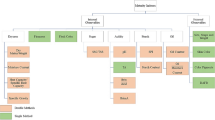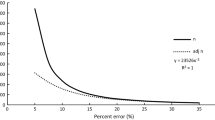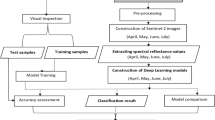Abstract
The fruit supply chain (FSC) involves different stages that need to be planned at least two months in advance. Therefore, having a good fruit yield forecast with anticipation allows making timely correct decisions for providing the resources, transport, and cold storage contracts, among others. Therefore, fruit yield over or underestimation could cause important inefficiencies with regards to FSC. Because of its relevance, a method based on machine learning (ML) techniques that uses spectrometric vegetation data is proposed. This method, known as Spectrometry Based Method for Fruit Production Forecast (SBM-Fruit), allows exploring the georeferenced Normalized Difference Vegetation Index (NDVI), collected in different phenological stages, aiming to capture spatial and temporal dependency in the fruit yield forecast. In the first step of SBM-Fruit, several clusters are obtained in a clustering process using the georeferenced NDVI in all phenological stages as input, while, in the second step, two validation functions are used for determining the best clustering. Finally, in the third step, the predictor variables of the best clustering are incorporated into an artificial neural network (ANN) for predicting the fruit yield. The SBM-Fruit was applied to forecast table grape yield of an orchard located in the Valparaíso Region, Chile. The results show fruit yield estimations with mean errors around 0.013 percent for every spatial zone of the orchard, forecasted at least two months in advance. The use of the SBM-Fruit would allow FSC stakeholders to make better decisions, improving the coordination of the FSC stages, and reducing costs and fruit losses.














Similar content being viewed by others
References
Aggarwal, C. C. (2018). Neural networks and deep learning. New York, USA: Springer Nature.
Ahmad, I., Saeed, U., Fahad, M., Ullah, A., Habib ur Rahman, M., Ahmad, A., & Judge, J. (2018). Yield Forecasting of Spring Maize Using Remote Sensing and Crop Modeling in Faisalabad-Punjab Pakistan. Journal of the Indian Society of Remote Sensing, 46(10), 1701–1711. https://doi.org/10.1007/s12524-018-0825-8
Ali, I., Cawkwell, F., Dwyer, E., & Green, S. (2017). Modeling managed grassland biomass estimation by using multitemporal remote sensing data-a machine learning approach. IEEE Journal of Selected Topics in Applied Earth Observations and Remote Sensing, 10(7), 3254–3264. https://doi.org/10.1109/JSTARS.2016.2561618
Anderson, N. T., Underwood, J. P., Rahman, M. M., Robson, A., & Walsh, K. B. (2019). Estimation of fruit load in mango orchards: Tree sampling considerations and use of machine vision and satellite imagery. Precision Agriculture, 20(4), 823–839. https://doi.org/10.1007/s11119-018-9614-1
Bai, T., Zhang, N., Mercatoris, B., & Chen, Y. (2019). Jujube yield prediction method combining Landsat 8 Vegetation Index and the phenological length. Computers and Electronics in Agriculture, 162, 1011–1027. https://doi.org/10.1016/j.compag.2019.05.035
Bezdek, J. C. (1984). FCM: The Fuzzy c-Means Clustering Algorithm. In Computers & Geosciences (Vol. 10, Issue 3).
Bohle, C., Maturana, S., & Vera, J. (2010). A robust optimization approach to wine grape harvesting scheduling. European Journal of Operational Research, 200(1), 245–252. https://doi.org/10.1016/j.ejor.2008.12.003
Bose, P., Kasabov, N. K., Bruzzone, L., & Hartono, R. N. (2016). Spiking Neural Networks for Crop Yield Estimation Based on Spatiotemporal Analysis of Image Time Series. IEEE Transactions on Geoscience and Remote Sensing, 54(11), 6563–6573. https://doi.org/10.1109/TGRS.2016.2586602
Caixeta-Filho, J. V. (2006). Orange harvesting scheduling management: A case study. Journal of the Operational Research Society, 57(6), 637–642. https://doi.org/10.1057/palgrave.jors.2602041
Catalá, L. P., Moreno, M. S., Blanco, A. M., & Bandoni, J. A. (2016). A bi-objective optimization model for tactical planning in the pome fruit industry supply chain. Computers and Electronics in Agriculture, 130, 128–141. https://doi.org/10.1016/j.compag.2016.10.008
Chuang, K. S., Tzeng, H. L., Chen, S., Wu, J., & Chen, T. J. (2006). Fuzzy c-means clustering with spatial information for image segmentation. Computerized Medical Imaging and Graphics, 30(1), 9–15. https://doi.org/10.1016/j.compmedimag.2005.10.001
de Salvador, F. R., Fisichella, M., & Fontanari, M. (2006). Correlations between fruit size and fruit quality in apple trees with high and standard crop load levels. Journal of Fruit and Ornamental Plant Research, 14(2), 113–122.
Efrom, B. (1979). Bootstrap Methods: Another Look at the Jackknife. The Annals of Statistics, 7(1), 1–26. https://doi.org/10.1214/aos/1176344552
Farooque, A. A., Chang, Y. K., Zaman, Q. U., Groulx, D., Schumann, A. W., & Esau, T. J. (2013). Performance evaluation of multiple ground based sensors mounted on a commercial wild blueberry harvester to sense plant height, fruit yield and topographic features in real-time. Computers and Electronics in Agriculture, 91, 135–144. https://doi.org/10.1016/j.compag.2012.12.006
Fernandes, J. L., Ebecken, N. F. F., & Esquerdo, J. C. D. M. (2017). Sugarcane yield prediction in Brazil using NDVI time series and neural networks ensemble. International Journal of Remote Sensing, 38(16), 4631–4644. https://doi.org/10.1080/01431161.2017.1325531
Ferrer, J. C., ma Cawley, A., Maturana, S., Toloza, S., & Vera, J. (2008). An optimization approach for scheduling wine grape harvest operations. International Journal of Production Economics, 112(2), 985–999. https://doi.org/10.1016/j.ijpe.2007.05.020
Ghaemi, R., Nasir Sulaiman, M., & Ibrahim, H. (2009). A Survey: Clustering Ensembles Techniques Towards an optimal feature subset selection View project Intrusion detection system View project. https://www.researchgate.net/publication/232700836
Gómez-Lagos, J. E., González-Araya, M. C., Blu, R. O., & Acosta Espejo, L. G. (2019). Using data mining techniques to forecast the Normalized Difference Vegetation Index (NDVI) in table grape. In ICORES 2019—Proceedings of the 8th International Conference on Operations Research and Enterprise Systems. https://doi.org/10.5220/0007570101890194
Gómez-Lagos, J. E., González-Araya, M. C., Soto-Silva, W. E., & Rivera-Moraga, M. M. (2021). Optimizing tactical harvest planning for multiple fruit orchards using a metaheuristic modeling approach. European Journal of Operational Research, 290(1), 297–312. https://doi.org/10.1016/j.ejor.2020.08.015
González-Araya, M. C., Soto-Silva, W. E., & Espejo, L. G. A. (2015). Harvest planning in apple orchards using an optimization model. In L. M. Plà-Aragonés (Ed.), Handbook of operations research in agriculture and the agri-food industry (pp. 79–105). New York: Springer. https://doi.org/10.1007/978-1-4939-2483-7_4
Hall, A., Lamb, D. W., Holzapfel, B. P., & Louis, J. P. (2011). Within-season temporal variation in correlations between vineyard canopy and winegrape composition and yield. Precision Agriculture, 12(1), 103–117. https://doi.org/10.1007/s11119-010-9159-4
Herrera-Cáceres, C., Pérez-Galarce, F., Álvarez-Miranda, E., & Candia-Véjar, A. (2017). Optimization of the harvest planning in the olive oil production: A case study in Chile. Computers and Electronics in Agriculture, 141, 147–159. https://doi.org/10.1016/j.compag.2017.07.017
Huete, A., Jd, W., & Leeuwen, V. (1999). MODIS vegetation index (MOD13) Impacts of extreme hydro-meteorological conditions on ecosystem functioning and productivity patterns across Australia View project Fingerprinting Australian ecosystem threats from climate change and biodiversity loss View project. https://www.researchgate.net/publication/268745810
International Society of Precision Agriculture. (2022). https://www.ispag.org/about/definition
Koirala, A., Walsh, K. B., Wang, Z., & McCarthy, C. (2019). Deep learning – Method overview and review of use for fruit detection and yield estimation. In Computers and Electronics in Agriculture (Vol. 162, pp. 219–234). Elsevier B.V. https://doi.org/10.1016/j.compag.2019.04.017
Koller, M., & Upadhyaya, S. K. (2005). Prediction of processing tomato yield using a crop growth model and remotely sensed aerial images. Transactions of the ASAE, 48(6), 2335–2341. https://doi.org/10.13031/2013.20072
Lamsal, K., Jones, P. C., & Thomas, B. W. (2016). Harvest logistics in agricultural systems with multiple, independent producers and no on-farm storage. Computers and Industrial Engineering, 91, 129–138. https://doi.org/10.1016/j.cie.2015.10.018
Mcculloch, W. S., & Pitts, W. (1943). A LOGICAL CALCULUS OF THE IDEAS IMMANENT IN NERVOUS ACTIVITY. In BULLETIN OF MATHEMATICAL BIOPHYSICS (Vol. 5).
Mihai, H., & Florin, S. (2016). Biomass prediction model in maize based on satellite images. AIP Conference Proceedings. https://doi.org/10.1063/1.4952132
Mistele, B., & Schmidhalter, U. (2010). Tractor-based quadrilateral spectral reflectance measurements to detect biomass and total aerial nitrogen in winter wheat. Agronomy Journal, 102(2), 499–506. https://doi.org/10.2134/agronj2009.0282
Moreda, G. P., Ortiz-Cañavate, J., García-Ramos, F. J., & Ruiz-Altisent, M. (2009). Non-destructive technologies for fruit and vegetable size determination—A review. Journal of Food Engineering, 92(2), 119–136. https://doi.org/10.1016/j.jfoodeng.2008.11.004
Negi, S., Anand, N., & Lscm, H. (. (2015). Cold Chain: A Weak Link in the Fruits and Vegetables Supply Chain in India Supply Chain Efficiency View project Calls for Papers (Special issue: Sustainable Procurement): International Journal of Social Ecology and Sustainable Development (IJSESD) View project Cold Chain: A Weak Link in the Fruits and Vegetables Supply Chain in India. In The IUP Journal of Supply Chain Management: Vol. XII (Issue 1). https://www.researchgate.net/publication/279866746
Ortega, R. A., Acosta, L. E., & Jara, L. A. (2012). Use of cluster regression for yield prediction in wine grape. Proceedings of the International Conference on Precision Agriculture, 1–8. https://ispag.org/proceedings/?action=abstract&id=1260&title=Use+of+Cluster+Regression+for+Yield+Prediction+in+Wine+Grape
Panda, S. S., Ames, D. P., & Panigrahi, S. (2010). Application of vegetation indices for agricultural crop yield prediction using neural network techniques. Remote Sensing, 2(3), 673–696. https://doi.org/10.3390/rs2030673
Pantazi, X. E., Moshou, D., Alexandridis, T., Whetton, R. L., & Mouazen, A. M. (2016). Wheat yield prediction using machine learning and advanced sensing techniques. Computers and Electronics in Agriculture, 121, 57–65. https://doi.org/10.1016/j.compag.2015.11.018
Rousseeuw, P. J. (1987). Silhouettes: A Graphical Aid to the Interpretation and Validation of Cluster Analysis. Comput. Appl. Math. 20, 53–65. Journal of Computational and Applied Mathematics, 20, 53–65. https://doi.org/10.1016/0377-0427(87)90125-7
Soto-Silva, W. E., González-Araya, M. C., Oliva-Fernández, M. A., & Plà-Aragonés, L. M. (2017). Optimizing fresh food logistics for processing: Application for a large Chilean apple supply chain. Computers and Electronics in Agriculture, 136, 42–57. https://doi.org/10.1016/j.compag.2017.02.020
Soto-Silva, W. E., Nadal-Roig, E., González-Araya, M. C., & Pla-Aragones, L. M. (2016). Operational research models applied to the fresh fruit supply chain. In European Journal of Operational Research (Vol. 251, Issue 2, pp. 345–355). Elsevier B.V. https://doi.org/10.1016/j.ejor.2015.08.046
Stateras, D., & Kalivas, D. (2020). Assessment of olive tree canopy characteristics and yield forecast model using high resolution uav imagery. Agriculture (Switzerland), 10(9), 1–13. https://doi.org/10.3390/agriculture10090385
Stein, M., Bargoti, S., & Underwood, J. (2016). Image based mango fruit detection, localisation and yield estimation using multiple view geometry. Sensors (Switzerland). https://doi.org/10.3390/s16111915
Sun, L., Gao, F., Anderson, M. C., Kustas, W. P., Alsina, M. M., Sanchez, L., Sams, B., McKee, L., Dulaney, W., White, W. A., Alfieri, J. G., Prueger, J. H., Melton, F., & Post, K. (2017). Daily mapping of 30 m LAI and NDVI for grape yield prediction in California vineyards. Remote Sensing, 9(4), 1–18. https://doi.org/10.3390/rs9040317
Uribeetxebarria, A., Martínez-Casasnovas, J. A., Tisseyre, B., Guillaume, S., Escolà, A., Rosell-Polo, J. R., & Arnó, J. (2019). Assessing ranked set sampling and ancillary data to improve fruit load estimates in peach orchards. Computers and Electronics in Agriculture. https://doi.org/10.1016/j.compag.2019.104931
van Dyk, F. E., & Maspero, E. (n.d.). An analysis of the South African fruit logistics infrastructure (Vol. 20, Issue 1). http://www.orssa.org.za
Varas, M., Basso, F., Maturana, S., Osorio, D., & Pezoa, R. (2020). A multi-objective approach for supporting wine grape harvest operations. Computers and Industrial Engineering, 145, 106497. https://doi.org/10.1016/j.cie.2020.106497
Villalobos, J. R., Soto-Silva, W. E., González-Araya, M. C., & González-Ramirez, R. G. (2019). Research directions in technology development to support real-time decisions of fresh produce logistics: A review and research agenda. In Computers and Electronics in Agriculture (Vol. 167). Elsevier B.V. https://doi.org/10.1016/j.compag.2019.105092
Xie, X. L., & Beni, G. (1991). A validity measure for fuzzy clustering. IEEE Transactions on Pattern Analysis and Machine Intelligence, 13(8), 841–847. https://doi.org/10.1109/34.85677
Ye, X., Sakai, K., Asada, S. I., & Sasao, A. (2008). Application of narrow-band TBVI in estimating fruit yield in citrus. Biosystems Engineering, 99(2), 179–189. https://doi.org/10.1016/j.biosystemseng.2007.09.016
Ye, X., Sakai, K., Manago, M., Asada, S. I., & Sasao, A. (2007). Prediction of citrus yield from airborne hyperspectral imagery. Precision Agriculture, 8(3), 111–125. https://doi.org/10.1007/s11119-007-9032-2
Acknowledgments
DSc. Marcela C. González-Araya would like to thank FONDECYT project 1191764 (Chile) for their financial support. MSc. Javier Gómez is grateful for the research funding provided under the CONICYT PFCHA/DOCTORADO BECAS CHILE 2019–21191364 (Chile).
Author information
Authors and Affiliations
Corresponding author
Additional information
Publisher's Note
Springer Nature remains neutral with regard to jurisdictional claims in published maps and institutional affiliations.
Supplementary Information
Below is the link to the electronic supplementary material.
Rights and permissions
Springer Nature or its licensor holds exclusive rights to this article under a publishing agreement with the author(s) or other rightsholder(s); author self-archiving of the accepted manuscript version of this article is solely governed by the terms of such publishing agreement and applicable law.
About this article
Cite this article
Gómez-Lagos, J.E., González-Araya, M.C., Ortega Blu, R. et al. A new method based on machine learning to forecast fruit yield using spectrometric data: analysis in a fruit supply chain context. Precision Agric 24, 326–352 (2023). https://doi.org/10.1007/s11119-022-09947-7
Accepted:
Published:
Issue Date:
DOI: https://doi.org/10.1007/s11119-022-09947-7




